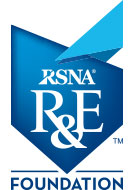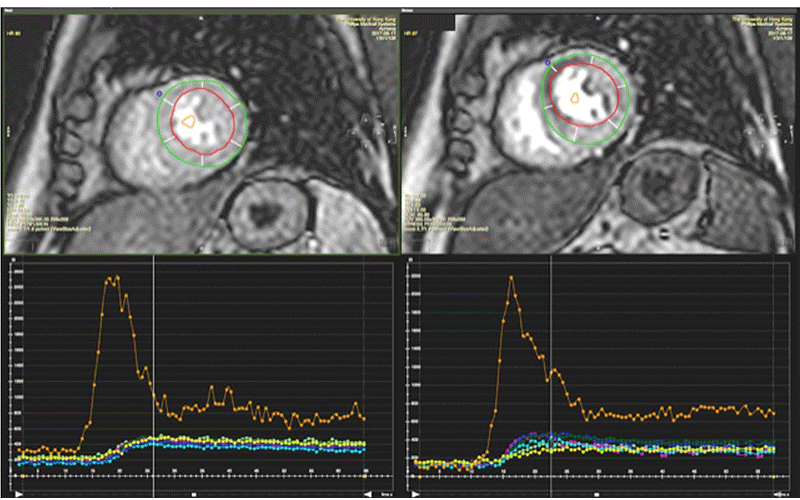Researcher Explores Potential Screening for Patients with Type 2 Diabetes and “Silent” Myocardial Ischemia
Cardiovascular disease remains the most common cause of death in type 2 diabetics


In a pilot study funded by the RSNA R&E Foundation, a research team at the University of Hong Kong (HKU) has laid the groundwork for exploring screening and therapies for patients with type 2 diabetes and coronary microvascular dysfunction.
“About 20% of asymptomatic patients with type 2 diabetes have silent ischemia,” said lead author Ming-Yen Ng, BMedSci, BMBS, clinical assistant professor, Department of Diagnostic Radiology, HKU. “Secondly, about 50% of patients have coronary microvascular dysfunction as seen on cardiac MR.”
Coronary microvascular dysfunction is becoming increasingly recognized as a significant risk for earlier death and myocardial infarcts, but currently there are no effective therapies. “Drugs that potentially improve coronary microvascular function could be studied using stress cardiac MR,” Dr. Ng said.
Funded with a 2017 RSNA Research Seed Grant, the study, “Cardiac Magnetic Resonance for Asymptomatic Type 2 Diabetics with Cardiovascular High Risk (CATCH),” included 60 patients with type 2 diabetes.
The researchers set out to determine the prevalence of myocardial ischemia and infarcts in high-risk diabetic patients with no symptoms. Dr. Ng and colleagues also examined how many cardiac MR examinations depicting myocardial ischemia could be falsely positive for significant epicardial coronary artery disease (CAD), leading to unnecessary catheter coronary angiograms (CCA) as determined by fractional flow reserve (FFR).
Results showed that 25 of the patients in this study (39.7%) had positive stress cardiac MR results, and infarcts were detected on five of those patients. Only two of the patients with infarcts had no evidence of stress perfusion defects.
In the 22 patients (66 coronary arteries) who underwent CCA per the research protocol, FFR was performed on 37 vessels (56.1%). The team used a software program to perform quantitative measurements of coronary artery narrowing in all patients.
The researchers found a 20.6% false-positive rate for asymptomatic obstructive CAD. “Perfusion defects in stress cardiac MR can be due to dark-rim artefacts,” Dr. Ng said. “However, our cases were double-reported by cardiac radiologists and were further reviewed by a third cardiac radiologist when a consensus could not be reached. One possible explanation for the false-positive rate is the presence of microvascular disease.”
"It is likely that a functional-based approach is required for future screening programs if coronary artery stenting is to be considered as a therapeutic option."
MING-YEN NG, BMEDSCI, BMBS
Functional-Based Approach is Effective
To assess for perfusion defects resulting from microvascular disease, which can be difficult to differentiate from obstructive CAD, the team analyzed the global myocardial perfusion reserve index (MPRI) in the patient cohort and determined that the low median MPRI value (1.38) indicated that half of the patients likely had microvascular disease.
“Further studies will need to be conducted in order to determine if microvascular disease could account for the high prevalence of ‘false’ positive stress cardiac MR,” Dr. Ng noted.
The team found a 39.7% prevalence of myocardial ischemia in the asymptomatic patients in their study.
“This is in keeping with the previously published results of 17% to 59%, which utilized nuclear myocardial perfusion and exercise stress testing,” Dr. Ng said. “However, as far as we are aware, there is no publication which has correlated non-invasive findings of myocardial ischemia with FFR.”
With FFR measurements, researchers showed that just under 15% of the total cohort had obstructive CAD.
These findings highlight the importance of functional assessment with FFR, Dr. Ng explained, because none of the vessels with an FFR rate of 0.8 or below had coronary artery narrowing of 70% or greater as determined by quantitative measurements.
“Without FFR, these vessels would have been classified as potentially non-obstructive coronary artery disease,” Dr. Ng said. “It is likely that a functional-based approach is required for future screening programs if coronary artery stenting is to be considered as a therapeutic option.”
RSNA Grant Leads to Further Research
Before receiving the RSNA grant, Dr. Ng had applied for a grant from the Health and Medical Research Fund (HMRF) in Hong Kong, and his team was advised to first acquire pilot data to consider the feasibility of a randomized controlled trial.
Using the data from the RSNA-funded study, Dr. Ng’s team has obtained provisional approval for a $185,000 grant from HMRF. Dr. Ng credits RSNA with launching his research career and leading to futher opportunities.
“This grant has been a significant springboard in my academic career in terms of applying for more grants and being able to get high quality preliminary data for initial publications,” Dr. Ng said. “The reputation of RSNA adds significant credentials to the subsequent application for external grant funding.”
Watch Dr. Ng discuss his study and how an RSNA R&E Foundation grant assisted with his research.
For More Information
For more information about RSNA R&E Foundation grants, visit RSNA.org/Research.
To support future R&E Foundation research, visit RSNA.org/Donate.
